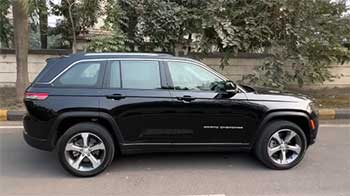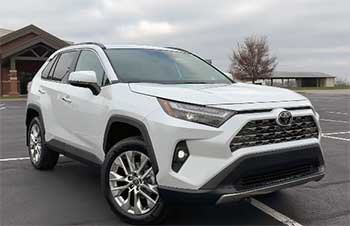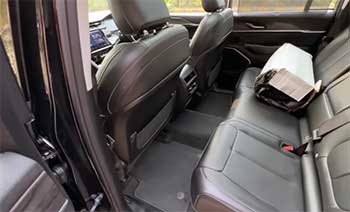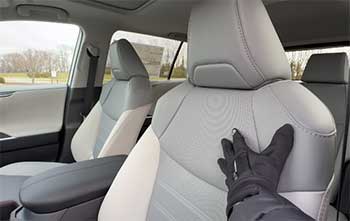I’ve been on the hunt for a new SUV, and after test-driving countless models, I’ve narrowed it down to the 2025 Jeep Grand Cherokee and the 2025 Toyota RAV4. These two vehicles stand out for their unique strengths, but choosing between them isn’t easy.
In this article, I’ll share my experience comparing their performance, features, reliability, and more, weighing the pros and cons to help you decide which SUV fits your life. From off-road adventures to daily commutes, let’s see which one comes out on top.
Comparison Table: Jeep Grand Cherokee vs. Toyota RAV4
| Feature | Jeep Grand Cherokee (2025) | Toyota RAV4 (2025) |
| Starting MSRP | $36,495 | $28,850 |
| Engine Options | 3.6L V6 (293 hp), 2.0L Turbo PHEV (375 hp) | 2.5L 4-cylinder (203 hp), Hybrid (219 hp) |
| Fuel Economy (Combined) | 22 MPG (Gas), 56 MPGe (PHEV) | 30 MPG (Gas), 39 MPG (Hybrid) |
| Cargo Space (Max) | 70.8 cu-ft | 69.8 cu-ft |
| Legroom (Front/Rear) | 41.3 in / 38.2 in | 41.0 in / 37.8 in |
| Towing Capacity | Up to 6,200 lbs (Gas), 2,722 lbs (PHEV) | Up to 3,500 lbs (Gas), 1,750 lbs (Hybrid) |
| Ground Clearance | 8.4–10.9 in (Trailhawk) | 8.4–8.6 in (TRD Off-Road) |
| Infotainment | 8.4–10.1 in Uconnect touchscreen | 7–9 in touchscreen, Toyota Safety Sense 2.5 |
| Safety Rating (NHTSA) | 5 Stars | 5 Stars |
| Reliability (J.D. Power) | 81/100 | 80/100 |
My Journey with the Jeep Grand Cherokee and Toyota RAV4
I’ve always had a soft spot for SUVs. Their versatility, from hauling groceries to weekend camping trips, makes them a perfect fit for my lifestyle. When it was time to upgrade, I focused on the 2025 Jeep Grand Cherokee and the 2025 Toyota RAV4. Both have strong reputations, and my time behind their wheels showed me why.
Performance: Power Meets Efficiency
The Grand Cherokee and RAV4 offer distinct experiences when it comes to power and fuel efficiency.
Jeep Grand Cherokee: A Beast on Any Terrain

The first time I drove the Jeep Grand Cherokee, I felt an immediate rush of power. Its base 3.6-liter V6 engine provides a commanding 293 horsepower.
The available 4×4 systems made it feel unstoppable, even on muddy off-road trails. The optional 2.0-liter turbocharged plug-in hybrid (4xe) offered impressive 375 horsepower and 25 miles of electric-only range.
However, the Grand Cherokee’s gas model fuel economy of 19 MPG city and 26 MPG highway was a drawback. The 4xe improves to 56 MPGe but comes with a higher price tag. The ride sometimes felt a bit soft on rough pavement compared to other SUVs.
Toyota RAV4: Nimble and Fuel-Savvy

The Toyota RAV4 felt like the more practical choice for daily driving. Its 2.5-liter four-cylinder engine delivers a respectable 203 horsepower, which is sufficient for city commutes.
The hybrid option, with 219 horsepower and 39 MPG combined, offered excellent fuel savings. I averaged around 35 MPG on a long road trip.
While the RAV4’s TRD Off-Road trim has decent capability with 8.6 inches of ground clearance, it isn’t built for rugged trails like the Jeep. Towing capacity is also limited, with a maximum of 3,500 pounds for the gas model. If you’re pulling anything heavier than a small trailer, the RAV4 might leave you wanting.
Pros and Cons: Performance
Jeep Grand Cherokee
- Pros: Powerful V6 and PHEV options deliver thrilling performance. Exceptional off-road capability, especially in Trailhawk trim. High towing capacity for larger loads.
- Cons: Poor fuel economy in gas models. Ride can feel less refined on rough roads. Higher trims are pricey.
Toyota RAV4
- Pros: Excellent fuel efficiency, especially in hybrid models. Smooth and responsive handling for city driving. Affordable performance across trims.
- Cons: Less powerful than the Jeep. Limited towing capacity. Off-road capability doesn’t match the Jeep’s prowess.
Interior and Comfort: Where You’ll Spend Your Time
This section highlights the differences in cabin experience between the two SUVs.
Jeep Grand Cherokee: A Touch of Luxury

Sliding into the Jeep Grand Cherokee feels like stepping into a premium hotel room. The Summit Reserve trim I tested featured quilted leather seats, real wood accents, and a sharp 10.1-inch Uconnect touchscreen.
Front seats offered heating, ventilation, and even a massage function. Both front and rear passengers enjoyed ample legroom.
Cargo space was generous, providing 37.7 cubic feet behind the second row and 70.8 cubic feet with seats folded.
My main critique was that the base Laredo trim felt less premium. The Uconnect system, though intuitive, occasionally lagged. The high cargo floor also made loading heavy items a bit challenging.
Toyota RAV4: Practical and Cozy

The RAV4’s interior is more functional than flashy. The XLE Premium trim I drove had durable SofTex seats and a comfortable leather-wrapped steering wheel.
The 9-inch touchscreen was user-friendly, with Apple CarPlay and Android Auto standard. I loved the straightforward layout, with no hunting for buttons in a sea of touchpads.
Cargo space was competitive, at 37.5 cubic feet behind the rear seats and 69.8 cubic feet max.
However, the RAV4’s cabin design can feel a bit dated. The base LE trim’s 7-inch screen seemed small, and road noise was noticeable on highways. While practical, it doesn’t exude luxury like the higher Grand Cherokee trims.
Pros and Cons: Interior and Comfort
Jeep Grand Cherokee
- Pros: Luxurious interior in higher trims with premium materials. Spacious cabin with ample legroom. Advanced Uconnect system with large touchscreen.
- Cons: Base trims feel less upscale. Uconnect can be sluggish at times. High cargo floor complicates loading.
Toyota RAV4
- Pros: Practical and spacious interior. User-friendly infotainment with standard smartphone integration. Competitive cargo space for the class.
- Cons: Cabin design feels less modern. Noticeable road noise on highways. Base trim’s small screen feels outdated.
Technology and Safety: Keeping You Connected and Safe
This section details the technological and safety features of both vehicles.
Jeep Grand Cherokee: Tech-Savvy with a Catch
The Jeep’s tech game is strong, supporting wireless Apple CarPlay and Android Auto, and an available 19-speaker McIntosh audio system. Safety-wise, the Grand Cherokee earned a 5-star NHTSA rating, with standard features like blind-spot monitoring and adaptive cruise control. However, some advanced features, such as the surround-view camera, are exclusive to expensive trims.
Toyota RAV4: Safety First, Tech Second
Toyota’s Safety Sense 2.5 comes standard across all RAV4 trims, offering robust features like pre-collision braking and lane-tracing assist. The RAV4 also holds a 5-star NHTSA rating. While the infotainment system is solid, it’s not as polished as the Jeep’s, and smaller screens on lower trims are a drawback. Blind-spot monitoring is not standard on the base LE model.
Pros and Cons: Technology and Safety
Jeep Grand Cherokee
- Pros: Advanced Uconnect system with premium audio options. Comprehensive safety suite with 5-star rating. High-tech features like parking assist in top trims.
- Cons: Some features reserved for pricier trims. Uconnect can lag occasionally.
Toyota RAV4
- Pros: Standard Toyota Safety Sense 2.5 across all trims. Reliable and intuitive tech interface. 5-star safety rating.
- Cons: Smaller screens on base trims. Blind-spot monitoring not standard on base model.
Reliability and Ownership Costs: The Long Game
This section compares the long-term reliability and expenses associated with each SUV.
Jeep Grand Cherokee: A Mixed Bag
Jeep’s reliability reputation has been inconsistent, but the 2025 Grand Cherokee scored an 81/100 from J.D. Power, slightly above average. Still, Consumer Reports suggests it’s less reliable than average, citing air suspension issues in older models. Five-year ownership costs are estimated at a high $62,965, including depreciation, fuel, and maintenance. The warranty coverage is decent but not class-leading.
Toyota RAV4: The Reliability King
The RAV4 is known for its strong reliability, with a J.D. Power score of 80/100 and a RepairPal rating of 4.0/5.0. Average annual repair costs are low at $429. The five-year ownership cost is significantly lower at $41,506, making it easier on the wallet. Toyota’s warranty is similar to Jeep’s, but the RAV4’s resale value is exceptional, retaining more value over time.
Pros and Cons: Reliability and Ownership
Jeep Grand Cherokee
- Pros: Above-average J.D. Power reliability score. Strong warranty coverage. Premium brand appeal.
- Cons: Higher ownership costs. Poorer resale value. Historical reliability concerns.
Toyota RAV4
- Pros: Excellent reliability ratings. Lower ownership costs. Strong resale value.
- Cons: Slightly lower J.D. Power score than Jeep. Less premium brand cachet.
Off-Road Capability: Where Jeep Shines
If you’re like me and love escaping to the wilderness, the Jeep Grand Cherokee is in a league of its own. The Trailhawk 4xe climbed a rocky hill with ease, feeling like a mountain goat with its low-range gearing and locking differential. The RAV4’s TRD Off-Road trim is respectable for light trails, but it’s not built for serious off-roading. I pushed it on a gravel path, and while it held its own, it lacked the Jeep’s confidence. For weekend warriors, the Jeep is the clear winner.
Daily Driving: RAV4’s Comfort Zone
For my daily commute, the RAV4 felt more at home. Its tighter turning circle made parking a breeze. The hybrid’s fuel savings were a godsend in stop-and-go traffic. The Jeep’s larger size and heavier steering made it less nimble in tight spaces, though its plush interior made long drives more comfortable. If your life is mostly city streets and errands, the RAV4’s practicality wins.
Price and Value: Budget vs. Premium
The RAV4’s starting price of $28,850 is a steal compared to the Jeep’s $36,495. Even fully loaded, the RAV4 Limited tops out at $37,155, while the Jeep’s Summit Reserve hits $63,040. For the price of a base Grand Cherokee, you’re getting a well-equipped RAV4 with better fuel economy and reliability. But the Jeep’s premium features and off-road prowess justify the cost if you value luxury and capability.
My Verdict: Which SUV Wins?
After weeks of test drives, I’m torn. The Jeep Grand Cherokee is my pick if you crave adventure, luxury, and raw power. Its off-road capability and upscale interior make it feel special. However, the higher costs and spotty reliability give me pause.
The Toyota RAV4 is the smarter buy for most people. It’s reliable, fuel-efficient, and affordable, with enough versatility for everyday life. If I’m being honest, I lean toward the RAV4 for its practicality. Yet, the Jeep’s rugged charm keeps calling me back.
Enhance Performance & Ride: Bilstein B6 vs. B8 Coilovers
Frequently Asked Questions (FAQ)
It depends on your needs. The RAV4 excels in reliability, fuel efficiency, and affordability, ideal for daily driving. The Jeep Grand Cherokee offers superior off-road capability and luxury but at a higher cost and with potential reliability concerns.
Toyotas, especially the RAV4, have a stronger reliability record, with lower average repair costs. Jeeps, like the Grand Cherokee, score slightly above average but have faced historical reliability issues.
The Jeep Grand Cherokee is larger overall. It provides more front legroom and greater maximum cargo space than the RAV4.
The Honda CR-V offers similar reliability with a more refined ride. The Mazda CX-5 provides sportier handling and a premium interior. Both are strong alternatives, depending on your priorities.
Conclusion: Your Road, Your Choice
You’re at a crossroads, just like I was, deciding between the Jeep Grand Cherokee and the Toyota RAV4. If you dream of off-road adventures and a luxurious ride, the Jeep’s power and style might steal your heart.
But if you want a reliable, budget-friendly SUV that sips fuel and handles daily life with ease, the RAV4 is tough to beat. Weigh your priorities—adventure or practicality—and test-drive both. Your perfect SUV is out there, and I hope my experience helps you find it.

